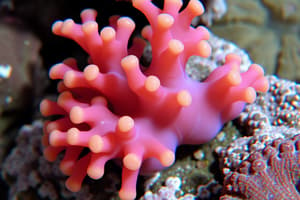Podcast
Questions and Answers
What is the color of the bioluminescence in Renilla koellikeri?
What is the color of the bioluminescence in Renilla koellikeri?
green
What is the internal skeleton of Muriciea californica made of?
What is the internal skeleton of Muriciea californica made of?
gorgonin
What structures in Anthopleura elegantissima are involved in fighting?
What structures in Anthopleura elegantissima are involved in fighting?
acrorhagi
What kind of septa do octocorals like Renilla koellikeri have?
What kind of septa do octocorals like Renilla koellikeri have?
Where is the GFP concentrated in Renilla koellikeri?
Where is the GFP concentrated in Renilla koellikeri?
What is the part of the octocoral anatomy that has eight sheets of tissue with gonads present on the sides and bottom of each chamber?
What is the part of the octocoral anatomy that has eight sheets of tissue with gonads present on the sides and bottom of each chamber?
What is the defining body shape of anthozoans?
What is the defining body shape of anthozoans?
Which anthozoan does not have a medusa stage in its life cycle?
Which anthozoan does not have a medusa stage in its life cycle?
Where is Nematostella vectensis found?
Where is Nematostella vectensis found?
How does Diadumene lineata reproduce?
How does Diadumene lineata reproduce?
Study Notes
- The text discusses various anthozoan species including the sea pansy Renilla, Nematostella vectensis, Corynactis californica, Exaiptasia pallida, and some unnamed species.
- Anthozoans are a group of animals that include sea anemones, corals, and their relatives, all characterized by having a columnar body shape and radial symmetry.
- Renilla is an excellent example of an anthozoan, it is a sea pansy and does not have a medusa stage in its life cycle.
- Nematostella vectensis, a model system in developmental biology, is a sea anemone that is transparent, important for research, and does not occur in southern California but is found in central and northern California, Oregon, and Washington.
- Corynactis californica is a corallimorph, similar to a sea anemone but with some slight differences in form. It is useful for understanding anthozoan morphology due to its transparency and presence of gonads on its septa.
- Exaiptasia pallida is a model system for cnidarian-algal symbiosis and has aconta, long filaments that help it capture prey and defend itself. It also hosts photosynthetic dinoflagellates which makes it harder to see into its body.
- Metridium, a species of anthozoan, has a siphonoglyph, a structure that helps it anchor itself to the substrate, and both complete and incomplete septa.
- Diadumene lineata is an actinarian that reproduces asexually by pedal laceration, and is not native to California but is widespread in bays and harbors.
- Anthopleura elegantissima is an intertidal anemone that reproduces both sexually and asexually, and has both complete and incomplete septa, and fights with structures called acrorhagi.
- Renilla koellikeri is a sea pansy, a colony of several types of polyps including autozooids and siphonozooids, and forms a hydrostatic skeleton with the help of water pressure generated by siphonozooids.- Autozooids and siphonozooids are visible in the text, with the exhalant siphonozooid identified as the one that lets water out.
- Autozooids can be retracted into the colony or extended out.
- Octocorals have eight complete septa, which are less visible in the polyps due to their transparency but are obvious in cross sections.
- The rachis, a mysterious part of the octocoral anatomy, has eight sheets of tissue with gonads present on the sides and bottom of each chamber.
- Renilla, an octocoral species, is known for its bioluminescence, which is green in color and is facilitated by GFP in the tissue.
- Bioluminescence gives off blue light, which is converted to green light by GFP in the tissue, and can be observed under a fluorescent microscope.
- GFP is concentrated on the clusters of siphonozooids.
- California golden gorgonian, Muriciea californica, is an octocoral species with a colony supported by an internal skeleton made of gorgonin.
- The internal skeleton consists of a central white medulla and dark brown cortex layers.
- A polyp in a section from the branch tip of a California golden gorgonian is seen brooding an egg or embryo.
Studying That Suits You
Use AI to generate personalized quizzes and flashcards to suit your learning preferences.
Description
Explore the diverse species of anthozoans including sea pansies, sea anemones, corals, and their unique characteristics such as bioluminescence, reproduction methods, and symbiotic relationships with algae. Gain insights into the anatomy and behavior of anthozoans through this informative text.



